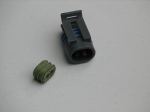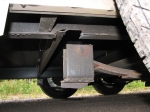| MIATA BUILD |
|
|
 |  | September 22, 2008 - So, the race is over.
It's time for a bit of analysis. What worked and what didn't? What would I change?
Ergonomically, the car was great. A bit small when it came to helmet wrangling on the transits, but if we had time we'd stick them in the trunk. The Backsaver pads in the seats get a big and hearty thumbs up, as they were comfortable all week long.
The Camelbaks were a big plus. We were sipping on them the entire time, and the hydration helped keep some of the fatigue at bay.
Having snacks in the car - goldfish crackers, tubes of honey, granola bars and often an apple or banana - made a big difference as well. It's a tip that we picked up from the California Rally School, and it kept us both in a better mood as well as more able to concentrate.
One thing that we definitely missed was transit headsets. We wore earplugs on long transits to keep the noise from wearing us down, but that meant we didn't get much chance to talk other than shouted conversation.
entry 603 - tags: post-race, ergonomics |  |  | September 22, 2008 - How did the suspension work?
On smooth stages, it was a joy. The car worked perfectly, giving me enough stability for confidence but remaining nimble enough to deal with surprises. I was able to adjust my line through corners without surprises, late braking didn't upset the car and I even ended up with some fairly high-speed trail braking by accident. In those situations, I could feel the tail getting light, but it never bit me.
On moderate bumps, the travel was good. We were able to soak up some big imperfections, especially on the high speed stuff. We could always put the power down.
The rough stuff - it's difficult to describe just how rough some of the stages are. The fact that on at least two occasions, we went over sharp speed bumps that weren't even in the notes is probably a good indication. For those stages, I needed better bumpstops, stiffer rear springs and more ride height. The Subaru guys were running gravel suspension, if that's any indication. The front end of the car worked really nicely, it was just the rear that wanted a bit more. Also, at full compression in the rear we were planting the rear subframe brace into the pavement so we actually had a bit too much compression travel for this sort of behaviour.
I raised the car a bit over the course of the week, but I was hesitant to go too far in case I damaged the high-speed behaviour. I'm going to keep working on this so I can find out how to make it work better. But holy cow, those were some big hits. The car never got upset and the chassis was protected enough to prevent any damage, but I usually have a bit more mechanical sympathy than that. I did get a report from my uncle Rob that while I was grounding out at times, it wasn't as bad as some of the other cars.
The shocks did gave us a scare early on as we discovered we'd blown right through the bumpstops and damaged the seals. The non-pressurised design of the shocks kept them from losing performance in this case, though.
entry 604 - tags: post-race, suspension |  |  | September 22, 2008 - Over the entire course of the race, the car never surprised me.
Not once. I never had to wrestle with it or deal with wayward behaviour. It simply did what I asked and always gave me an option in case I wanted to do something else.
In short, it was a Miata.
That left me free to concentrate on Janel's instructions and the road. I can't emphasize how important that was - it's why others commented on how smooth we looked. The car simply didn't have any bad habits. More than a year of constant testing and thousands of miles at race speeds in this and other Miatas were a real benefit, as the car's handling is second nature to me and heck, they flatter any driver.
entry 605 - tags: post-race.suspension, testing |  |  | September 22, 2008 - The drivetrain worked out well.
The engine was flexible enough that even when I lost the top 2500 rpm of the rev range, I was still able to make good time. It used almost no oil over 2200 km of driving including 500+ km of full-throttle stages. More power would have been nice, but I think that's the lament of every driver.
I launched the car with smoking tires every single time and there were no problems. I did misjudge the start a couple of times and left the line with lots of clutch slip instead of tire smoke, but the clutch took it without complaint.
The misfire? Well, I'll figure out what it was shortly. I did discover yesterday that one of the wires to the intake air temperature sensor is broken. There was about 8" of unsupported wire leading up to the sensor, and the vibration and pounding made this about 6" too much. I'll fix it when I get a chance and see if that solves the problem.
entry 606 - tags: post-race, engine |  |  | September 22, 2008 - The brakes were perfect all week.
Nice and powerful but easy to modulate. Of course, Miatas are easy on brakes. The Challenger was not, and this cost them dearly when the rotors taco'd at the beginning of the long and fast Leading Tickles stage. I didn't even have to bleed my brakes. That's the result of a light car that's fast in the corners and (relatively) slow in the straights, of course.
The adjustable proportioning valve did come into play over the week, as I'd adjust the bias to get a different behaviour under certain conditions.
entry 607 - tags: post-race, brakes |  |  | September 22, 2008 - The Toyos worked out well.
The RA-1, of course, is a very friendly tire that doesn't surprise the driver at the limit. I drove well within those limits over the week, with a couple of exceptions where I took advantage of every bit of grip available to me.
In the wet, the car was great. It's almost a shame we didn't have more wet stages, as it turned out that we were very competitive under those conditions. I don't have much wet weather racing experience (and all of that came over the course of the Targa!) so I was quite reassured at how well the car worked there.
The R888 tires might have been stickier and I certainly saw them on a number of cars. Tire wear wasn't an issue for us at all, so they'd be a good option. I'd want to know how they work in deep water first though.
entry 608 - tags: post-race, tires |  |  | September 26, 2008 - I think I solved the misfire issue that appeared near the end of the race.
As I discovered right after the race, a wire to the air intake temperature sensor had broken. I patched that up today - a very temporary fix, but one that was good enough for testing - and the car seems healed. It'll pull hard to redline in at least three gears, which is something it would not do on the last stages. So we'll call that a success then.
It's a real testament to the flexibility of the engine that losing 2500 rpm of my rev range wasn't a crippling blow. Yes, the car was a bit slower getting up to speed. But I was able to drive around it, and we zeroed one stage and took a 2 second penalty on another like this. Compared to the penalties on day 3, that's nothing.
entry 612 - tags: engine, post-race |  |  |  | September 28, 2008 - The culprit.
The broken wire in this connector - which quickly became two broken wires when I poked at it - appears to be the cause of the misfire.
entry 614 - tags: engine, post-race |  |  |  | September 28, 2008 - A bit of excitement on the way home.
Coming off the Newfoundland ferry, I heard a few odd clunks from the trailer. At the next fuel stop, I kicked a wheel and it moved. That's not good. A peek underneath showed that a rear spring hanger had ripped off. Probably the road coming into Argentia.
Rural areas are where you want to have this kind of failure. A couple of quick inquiries sent us to Lloyd's fantastic shop in the woods, surrounded by forestry equipment and other industrial stuff. Perfect. They fixed up the broken hanger carefully and well, and found a similar crack on the other side. We lost a few hours of travel time, but no harm was done.
entry 615 - tags: post-race, trailer |  |  |  | September 30, 2011 - Overall, the car is in excellent shape.
The rear subframe brace took the worst beating, which wasn't a surprise. Ground clearance back there is at a bit of a premium and my experience in 2008 was that the back was the most likely place to hit. The skid plate/brace did exactly what it was supposed to do and protected the important bits.
Elsewhere, there's very little sign that the car just finished such an ordeal. In fact, all we need to do is bang the rear skid plate into shape and we could run another week. Even the tires would be good for a few more days of racing. We replaced a coil that had heatsoak problems due to my heat shielding, had a video camera die (and lost a GoPro off the roof at speed) and of course lost the main relay. But overall, the car proved itself to be a strong and reliable tool with a huge turn of speed. By contrast, I was speaking to one of the MINI drivers after the event and he had a big list of problems to fix. For example, both of his front upper strut mounts were damaged and he'd replaced them once or twice already during the race. We had no similar concerns.
I've also been thinking about The Relay. At the time it happened, I felt that I should have been able to fix it on the side of the road and rejoin the race without the DNF for one stage. However, it wouldn't have made any difference in the end. By the time we'd extricated ourselves from the car, set up the triangles and OK sign, instantly diagnosed the problem, reloaded ourselves and rejoined the stage, we would have lost too much time to catch the Challenger and the M3 that finished ahead of us.
entry 1006 - tags: impact protection, skid plate, post-race |  |  |
|

 THE DIARY
THE DIARY